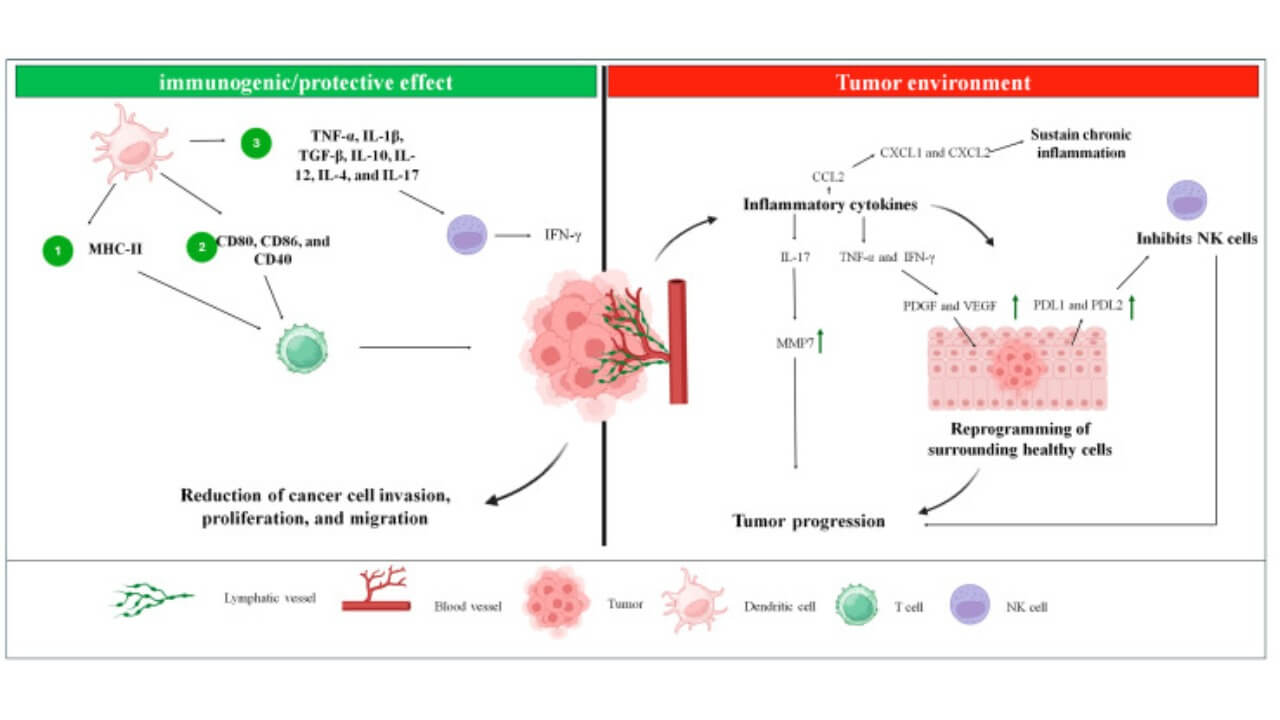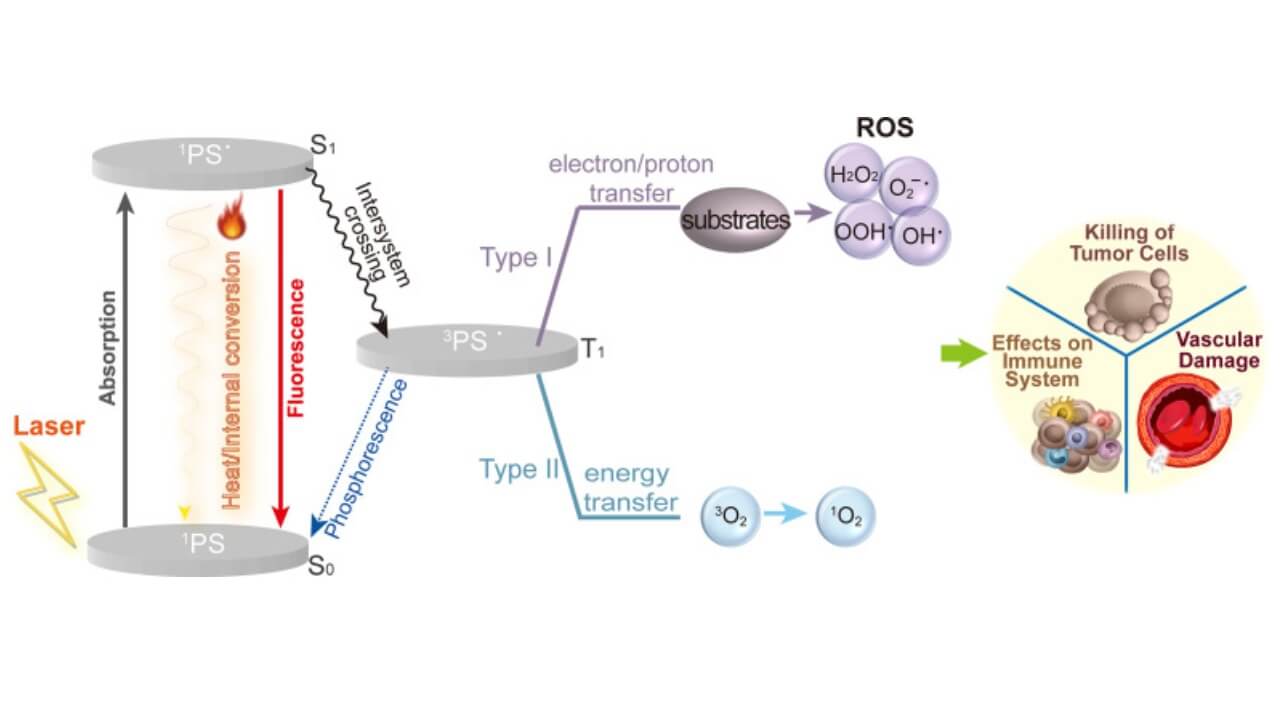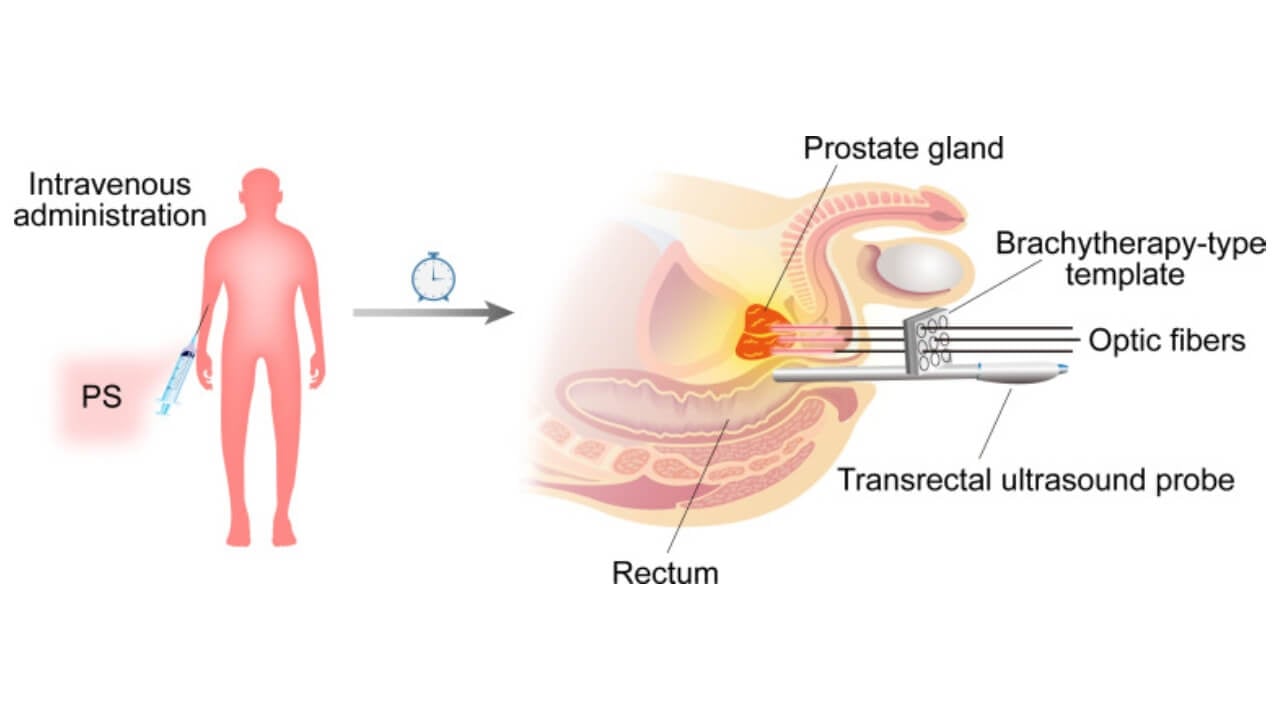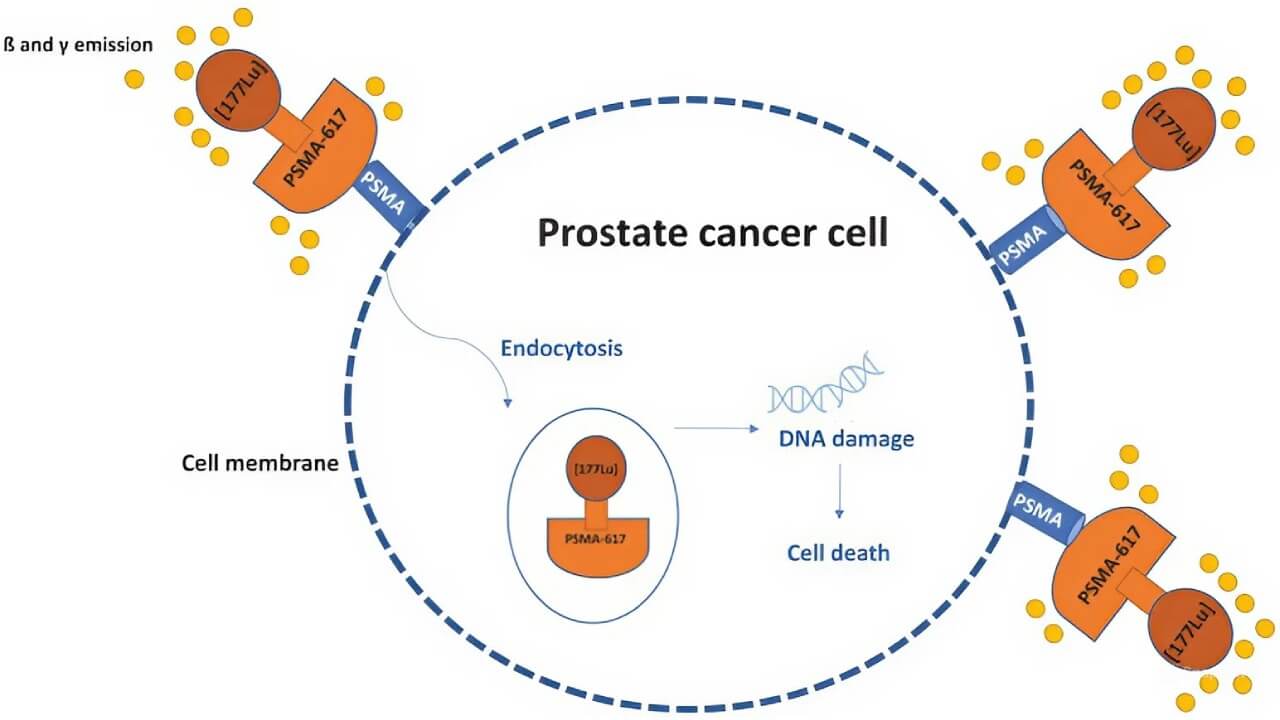Prostate cancer is the most common malignant tumor in men and a major cause of cancer-related death worldwide. According to the World Health Organization (WHO) and Global Cancer Observatory (GLOBOCAN 2022), more than 1.4 million new cases of prostate cancer are diagnosed each year, accounting for nearly 15% of all cancers in men [1]. The disease is strongly linked to age, as the majority of patients are diagnosed after 65 years. This explains why incidence is higher in economically developed countries, where life expectancy is longer.
Although many patients search for a clear prostate cancer definition, it is more than just a localized tumor of the prostate gland – it is a disease that can spread, metastasize, and significantly affect quality of life. Fortunately, the survival rate depends heavily on early detection and access to advanced treatment. In countries with advanced healthcare systems, such as Germany, survival outcomes are among the highest in the world thanks to innovations like robotic surgery, radionuclide therapy, and immunotherapy.
What Is Prostate Cancer?
Prostate cancer is a malignant tumor that develops in the prostate gland, an organ located below the bladder and in front of the rectum. The prostate produces seminal fluid, which nourishes and transports sperm. When abnormal cells in the gland begin to grow uncontrollably, a tumor forms, which can eventually spread to other parts of the body [1-3].
Most Common Types of Prostate Cancer
- Adenocarcinoma is by far the most frequent form, diagnosed in about 95% of cases. It develops from the glandular cells of the prostate, which normally produce fluid for semen.
- Less common variants include mucinous, ductal, small-cell, and transitional-cell carcinomas.
Tumor Differentiation in Prostate Cancer
Pathologists classify prostate tumors by how much the cancer cells resemble normal prostate tissue under a microscope (a process called differentiation).
- Well-differentiated (low-grade): Grow slowly and usually have a more favorable prognosis.
- Moderately differentiated: Intermediate behavior.
- Poorly differentiated/undifferentiated (high-grade): Grow aggressively, spread early, and have a worse survival rate.
This classification is often expressed by the Gleason score, a grading system from 6 to 10. The higher the score, the more aggressive the tumor is likely to be.
Zones of Prostate Cancer Origin
Prostate cancer can begin in different zones (areas) of the gland:
- Peripheral zone (PZ) – ~65%-70% of cases; usually detectable on rectal exam
- Central zone (CZ) – ~5%-10% of cases; harder to detect clinically
- Transition zone (TZ) – ~20%-25% of cases; tumors here can obstruct urine flow
Overall, prostate cancer is a heterogeneous disease. Some tumors grow so slowly that they cause few problems, while others progress rapidly. This is why early detection and access to modern treatment approaches are essential for improving quality of life and long-term survival rate.
Prostate Cancer Causes and Risk Factors
The exact cause of prostate cancer remains unknown, but researchers have identified several risk factors that increase the likelihood of developing the disease. Some cannot be changed, while others are linked to lifestyle choices and may be managed with preventive steps [2, 3].
Uncontrolled Prostate Cancer Risk Factors
These cannot be modified, but they explain why some men are more likely to be diagnosed:
- Age – Prostate cancer is rare before age 50, and about 60% of cases occur after age 65.
- Heredity (family history) – Having a close relative, such as a father or brother, with prostate cancer makes a man about 2-3 times more likely to develop it.
- Race and ethnicity – African American men have the highest incidence and mortality, while men of Asian descent have the lowest.
- Geography – Prostate cancer is most common in North America and Northern and Western Europe, and much less frequent in Asia and Latin America.
Controlled Prostate Cancer Risk Factors
These are related to lifestyle and can be improved:
- Diet – High intake of red meat, dairy products, and calcium has been linked to increased risk, while fruits and vegetables are protective.
- Obesity – Being overweight does not directly cause cancer, but it is linked to faster-growing and more dangerous tumors.
- Profession – Firefighters and workers exposed to harmful chemicals may be more likely to develop prostate cancer.
Unproven Prostate Cancer Risk Factors
Some factors have been studied, but the evidence is still unclear:
- Smoking
- Chronic prostatitis (long-term prostate inflammation)
- Sexually transmitted infections
- Vasectomy (male sterilization surgery)
- Radiation exposure
- High levels of male hormones (androgens) may speed up tumor growth, but are not a direct cause
Knowing about these risks helps men make informed lifestyle choices and discuss screening with their doctors, especially if they have a family history or other strong risk factors.
Types and Stages of Prostate Cancer
Doctors classify prostate cancer using two main systems: the TNM system, which shows how far the cancer has spread, and the Gleason/ISUP grading system, which describes how aggressive the cancer cells look under a microscope. These classifications help doctors choose the best treatment plan and give an idea of prognosis [2, 3].
TNM Prostate Cancer Classification
T (Tumor): Describes the size and extent of the tumor in the prostate.
- T1 – Very small, microscopic tumor, not detectable on exam or imaging
- T2 – Tumor limited to the prostate (one or both lobes)
- T3 – Tumor grows beyond the prostate's natural boundary (capsule)
- T4 – Tumor spreads into nearby organs, such as the bladder or rectum
N (Nodes): Whether cancer has spread to nearby lymph nodes.
- N0 – No lymph node involvement
- N1 – Cancer has reached the regional lymph nodes
M (Metastasis): Whether the cancer has spread to distant parts of the body.
- M0 – No distant spread
- M1 – Spread to bones, lungs, liver, or distant lymph nodes
Tumor Grading (Gleason/ISUP System)
Pathologists also evaluate tumor differentiation (how closely cancer cells resemble healthy prostate cells):
- G1: Cells look almost normal; cancer grows slowly
- G2: Moderately abnormal; intermediate growth
- G3: Quite abnormal; faster-growing cancer
- G4: Very abnormal; highly aggressive and more likely to spread quickly
Clinical Stages of Prostate Cancer
Based on TNM and grading, prostate cancer is divided into four stages:
- Stage I – Small, localized, slow-growing tumor
- Stage II – Tumor still confined to the prostate, may involve both lobes
- Stage III – Cancer extends outside the prostate (e.g., into seminal vesicles) but not distant organs
- Stage IV – Cancer has spread to nearby organs, or distant metastases are present
Importance of Prostate Cancer Staging
The stage at diagnosis is the strongest predictor of outcome. For example, the prostate cancer survival rate by stage exceeds 95% in stages I-II, meaning most men live many years after successful treatment. In stage IV, when metastases are present, the five-year survival rate falls to about 30-37% [4].
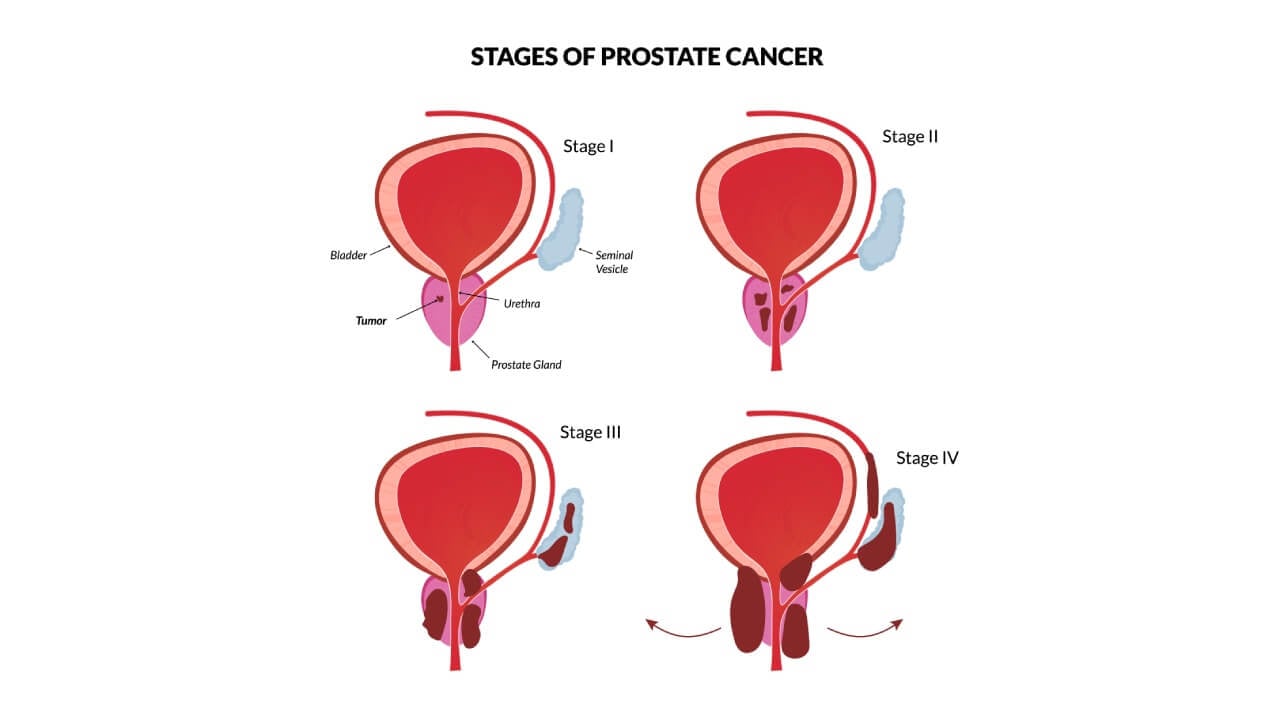
Where Prostate Cancer Metastasizes Most Often
Prostate cancer tends to spread in a predictable way. The first place it usually spreads is the nearby lymph nodes in the pelvis or abdomen. If the disease progresses further, it may affect distant organs or bones [2-4].
Common Metastatic Sites of Prostate Cancer
- Lymph nodes – These are filters of the immune system. When cancer cells enter them, they may block drainage and cause swelling.
- Bones – The most frequent site of distant metastasis. Prostate cancer often spreads to the ribs, pelvis, or spine, which can cause bone pain, fractures, or pressure on the spinal cord.
- Lungs – Less common, but possible in advanced disease.
- Liver – More often affected in late stages or with aggressive cancers.
Role of PSA and Biomarkers in Prostate Cancer
The prostate-specific antigen (PSA) blood test not only helps diagnose prostate cancer but also shows how advanced it may be:
- Very high PSA levels (>50 ng/mL) often suggest the cancer has grown beyond the prostate
- Extremely high PSA (>100 ng/mL) usually indicates that metastases are already present
In addition, doctors may also check other markers, such as alkaline phosphatase, which may point to bone involvement. These tests help specialists decide which treatments will work best.
Prostate Cancer Survival Rates
Compared to many other cancers, prostate cancer often has a more favorable outcome, especially when it is detected early and treated in specialized centers. Survival depends on several factors: the stage at diagnosis, how aggressive the tumor is, and whether patients can access advanced therapies. Globally, results differ: men in countries with well-developed healthcare systems usually live much longer after diagnosis than those in regions where modern treatment is harder to access [4].
Global Statistics for Prostate Cancer
In Western countries, the five-year relative survival rate is about 99%, the 10-year rate is ~98%, and the 15-year rate is ~96% [4]. By comparison, in developing countries where screening and treatment options are limited, long-term survival is often less than 50% [1].
Prostate Cancer Survival Rate by Stage
- Stage I-II: Prognosis is excellent, with >95% five-year survival. Many patients achieve complete remission after surgery or radiation therapy.
- Stage III: Outcomes remain favorable if treated aggressively. With a combination of surgery, radiation therapy, or brachytherapy, survival exceeds 70-80% at 10 years.
- Stage IV: The most challenging stage. With distant metastases, the five-year survival rate averages ~37% [4].
Key Prognostic Factors in Prostate Cancer
Doctors look at several aspects when estimating outlook:
- Tumor stage and grade (how advanced and aggressive the cancer is)
- PSA levels at diagnosis
- Response to therapy (surgery, radiation, systemic treatments)
- Access to specialized cancer centers
| Stage | Typical Tumor Spread | 5-Year Survival Rate | 10-Year Survival Rate | 15-Year Survival Rate |
|---|---|---|---|---|
| Stage I | Tumor confined to the prostate, highly differentiated | ~99% | ~98% | ~96% |
| Stage II | Tumor confined, moderate/variable differentiation | ~99% | ~95-97% | ~93-95% |
| Stage III | Local spread beyond the capsule, no distant metastases | ~85-95% | ~70-80% | ~60-65% |
| Stage IV | Distant metastases present | ~37% | ~15-20% | <10% |
These figures show how much the prostate cancer survival rate by stage improves with early diagnosis. While the numbers for advanced disease may seem discouraging, it is important to remember that they are based on older data. With today's innovative treatments, especially in Germany, many patients with advanced prostate cancer are living longer and more fulfilling lives than ever before.
Prevention of Prostate Cancer
There is no guaranteed way to prevent prostate cancer, but many healthy lifestyle choices can lower the risk and improve overall well-being. Research suggests that men who eat more fruits, vegetables, whole grains, and healthy fats are less likely to develop aggressive forms of the disease. Cutting down on red meat and high-fat dairy products may also be beneficial.
Staying active and maintaining a healthy weight play an important role as well. Regular exercise not only reduces cancer risk but also supports heart health, energy levels, and mental well-being.
Screening is another key step in prevention. An annual PSA blood test – together with regular check-ups – can detect prostate cancer at an earlier stage, when treatment is more effective and outcomes are better.
While no strategy offers complete protection, adopting these habits helps men take control of their health, reduce risks, and improve their long-term quality of life [5].
Modern Prostate Cancer Treatment in Germany
Germany is internationally recognized for its cancer care. Patients benefit from a combination of proven methods – like surgery and radiation therapy – and innovative options such as Lutetium-177 radionuclide therapy, dendritic cell immunotherapy, and photodynamic therapy. Access to such modern prostate cancer treatment in Germany gives men the best chance of long-term survival and a good quality of life.
Surgery (Radical Prostatectomy and TURP) for Prostate Cancer
Surgery is the most common curative option when the cancer is confined to the prostate [6].
Radical prostatectomy removes the prostate gland and sometimes nearby lymph nodes. In Germany, this is often performed using the Da Vinci robotic system, which allows:
- High precision
- Less blood loss
- Faster recovery
- Better preservation of urinary and sexual function
TURP (Transurethral Resection of the Prostate) is not a cure for cancer, but it helps men with advanced tumors or prostate enlargement who struggle with urination. By removing excess prostate tissue, TURP improves quality of life and prevents complications like urinary blockage.
Radiation Therapy and Brachytherapy for Prostate Cancer
Radiation therapy is often used instead of surgery, especially for patients who cannot undergo an operation. German hospitals use highly advanced methods:
- External beam radiation therapy (EBRT): High-energy rays destroy tumor cells while sparing healthy tissue.
- Intensity-modulated radiation therapy (IMRT): Provides even more precision with fewer side effects.
Brachytherapy (internal radiation) is another option, where tiny radioactive seeds are placed directly inside the prostate. This delivers high-dose radiation to the tumor while protecting surrounding organs. In the early stages, results are similar to surgery [7].
Innovative Options for Prostate Cancer: Dendritic Cells, PDT, and Lutetium 177 PSMA Therapy in Germany
Germany is a leader in advanced prostate cancer therapies:
- Dendritic cell immunotherapy: Doctors collect a patient's immune cells, "teach" them to recognize prostate cancer, and reintroduce them to the body. This stimulates a strong immune attack against the tumor. This prostate cancer immunotherapy in Germany is especially useful for advanced or recurrent disease [8].
- Photodynamic therapy (PDT): A light-sensitive drug is injected into the body and activated with laser light to destroy tumor cells. It is minimally invasive and sometimes combined with other therapies [9].
- Lutetium 177 PSMA therapy: This treatment attaches a radioactive lutetium molecule to a substance that finds prostate cancer cells. It delivers radiation directly to the tumor, sparing healthy tissue. Studies show it helps men with advanced cancer live longer and reduces pain [10].
Other Methods of Prostate Cancer Treatment
In addition to surgery and radiation, German oncologists often use systemic treatments that work throughout the body. These options are especially important for men with advanced or resistant disease:
- Hormone therapy lowers testosterone, the main "fuel" for prostate cancer cells. It can shrink tumors and slow progression, often used together with other treatments.
- Chemotherapy is helpful when the cancer no longer responds to hormones. It can reduce symptoms, improve quality of life, and extend survival.
- New systemic therapies, such as PARP inhibitors and checkpoint inhibitors, activate the body's immune system against cancer. These are innovative options available at leading centers.
These methods are frequently combined with local treatments to create personalized strategies. Even when standard options are no longer effective, innovative approaches in Germany continue to provide patients with meaningful improvements and longer survival.
| Treatment Method | Description | 5-Year Survival Rate (approx.) | Notes and Patient Outlook |
|---|---|---|---|
| Surgery (Radical Prostatectomy, incl. robotic) | Removal of the prostate, often curative in early stages | ~90-99% (stages I-II) | Considered the gold standard for localized disease. Many men return to normal life. |
| TURP (Transurethral Resection of the Prostate) | Relieves urinary obstruction | Improves quality of life | Not a cure, but it helps patients with advanced cancer feel more comfortable. |
| Radiation Therapy (IMRT, EBRT) | High-precision external irradiation | ~85-95% (early stages) | Often chosen when surgery is not possible. Preserves good quality of life. |
| Brachytherapy | Radioactive seeds are placed in the prostate | ~85-95% (stages I-II) | Excellent outcomes for early disease with fewer side effects. |
| Lutetium-177 PSMA Therapy | Radioactive molecule targets prostate cancer cells | ~65-75% survival benefit in advanced cancer | Gives hope to men with metastatic disease who no longer respond to standard therapy. |
| Dendritic Cell Immunotherapy | Stimulates the immune system to attack the tumor | ~60-70% in advanced cancer | A promising, highly personalized therapy available in German clinics. |
| PDT (Photodynamic Therapy) | Drug + light therapy that destroys the tumor locally | ~70-80% (selected cases) | Minimally invasive; can be repeated if needed. |
Best Hospitals in Germany for Prostate Cancer Treatment
Patients seeking the best prostate cancer hospitals in Germany benefit from centers that combine advanced technologies, world-famous specialists, and individualized treatment plans. These hospitals are recognized not only in Germany but internationally for their leadership in robotic surgery, radionuclide therapies, and immunotherapy.
- Helios Hospital Berlin-Buch – A leading oncology hospital offering robotic prostate surgery with the Da Vinci system, advanced radiation therapy, and innovative radionuclide approaches such as Lutetium 177 PSMA therapy in Germany. Each year, thousands of men with prostate cancer, including international patients, undergo treatment here.
- University Hospital Tübingen – One of the most research-active centers in Germany. It is well known for its work in dendritic cells immunotherapy and radionuclide treatments. The hospital runs numerous clinical trials and is often the first to introduce innovative cancer therapies.
- LMU Klinikum Munich – Among the largest academic hospitals in Europe, offering comprehensive prostate cancer care. Patients here benefit from multidisciplinary tumor boards, advanced diagnostics, and access to experimental therapies not widely available elsewhere.
| Treatment Method | Approximate Cost in Germany (€) | Notes |
|---|---|---|
| Surgery (Radical Prostatectomy, incl. robotic) | €25,000-€45,000 | Curative option for localized cancer; robotic surgery improves recovery |
| TURP (Transurethral Resection of the Prostate) | €6,800-€12,000 | Symptom relief, improves urination, not a curative procedure |
| Radiation therapy (IMRT/EBRT) | €28,000-€42,000 | Non-surgical option; often combined with hormone therapy |
| Brachytherapy | €12,000-€16,000 (average market range) | Radioactive seeds implanted in the prostate, effective in the early stages |
| Lutetium-177 PSMA Therapy (per cycle) | €12,700-€28,900 | Targeted radionuclide therapy for advanced and metastatic cancer |
| Dendritic Cell Immunotherapy (per cycle) | €20,000-€38,000 | Personalized cancer vaccine that stimulates the immune system |
| Photodynamic Therapy (PDT) | €7,000-€11,000 | Minimally invasive, used in selected localized or recurrent cases |
| Chemotherapy (full course) | €80,000-€150,000 | Used for advanced or hormone-resistant prostate cancer |
*Prices are approximate and depend on the clinic, treatment plan, and stage of disease.
Patient Story: Robert Allen Ruleford, USA – Prostate Cancer Treatment at Helios Hospital Berlin-Buch
Hearing from other patients can be a source of comfort and inspiration when facing a serious diagnosis. Many men choose Germany for prostate cancer treatment not only because of advanced medical technologies, but also because of the attentive and professional care provided by experienced specialists.
Robert Allen Ruleford from the USA explained that when he was diagnosed with prostate cancer, he and his wife initially felt overwhelmed by the number of treatment options. With the help of Booking Health, they connected with Prof. Dresel at Helios Hospital Berlin-Buch.
From the very first consultation, Robert felt reassured by his doctor's expertise. The medical team recommended robotic surgery, which was performed with great precision. His recovery went more smoothly than expected, and his concerns about side effects were carefully addressed. He noted that the staff's attention to detail made both him and his wife feel supported at every step.
Today, Robert's PSA levels remain stable, and he has returned to a normal, active life. He expressed deep gratitude for the excellent care and coordination he received – and encourages other men facing prostate cancer to explore the advanced options available in Germany.
International Cancer Care: Patient Stories with Booking Health
A Medical Journey: Every Step of the Way With Booking Health
Finding the best treatment strategy for prostate cancer can be overwhelming. Patients often face numerous consultations, conflicting medical opinions, and exhausting treatment experiences. In such a situation, it is easy to settle for the first available option or follow standard protocols that may not always provide access to the latest innovations. This is where Booking Health becomes a trusted partner.
For more than 12 years, Booking Health has been guiding patients through every stage of their medical journey. The company helps men with prostate cancer receive access to advanced treatment options in Germany, including robotic surgery, radiation therapy, brachytherapy, Lutetium-177 PSMA therapy, dendritic cell immunotherapy, and photodynamic therapy.
What Booking Health provides:
- Assessment and analysis of medical reports
- Development of an individual treatment program
- Direct booking with the most suitable clinic
- Preparation and translation of medical documentation
- Insurance to cover unforeseen complications (guaranteed fixed cost)
- Assistance with visas, flights, and logistics
- Personal interpreter and coordinator available 24/7
By coordinating care with the best prostate cancer hospitals in Germany, patients benefit from personalized treatment plans, transparent pricing with no hidden costs, and access to innovative therapies not always available in their home country.
Health is invaluable, and its management should only be entrusted to experienced professionals. Booking Health prostate cancer coordination ensures that every step – from diagnosis to treatment and recovery – is carefully managed for the best possible outcome.
Contact Booking Health today to explore advanced prostate cancer treatments in Germany and start your journey toward recovery with world-class specialists.
Choose treatment abroad, and you will get the best results for sure!
Authors:
This article was edited by medical experts, board-certified doctors Dr. Nadezhda Ivanisova, and Dr. Bohdan Mykhalniuk. For the treatment of the conditions referred to in the article, you must consult a doctor; the information in the article is not intended for self-medication!
Our editorial policy, which details our commitment to accuracy and transparency, is available here. Click this link to review our policies.
Source:
[1] Frontiers in Public Health. Prostate Cancer Incidence and Mortality: Global Status and Temporal Trends in 89 Countries From 2000 to 2019. https://www.frontiersin.org/journals/public-health/articles/10.3389/fpubh.2022.811044/full
[2] Biochimica et Biophysica Acta (BBA) - Molecular Cell Research. The Molecular and Cellular Origin of Human Prostate Cancer. https://www.sciencedirect.com/science/article/pii/S0167488916300416
[3] Xudong Yu, Ruijia Liu, Lianying Song et al. Differences in the pathogenetic characteristics of prostate cancer in the transitional and peripheral zones and the possible molecular biological mechanisms. Front Oncol. 2023 Jun 30;13:1165732. doi: 10.3389/fonc.2023.1165732. [DOI] [PMC free article]
[4] American Cancer Society. Survival Rates for Prostate Cancer. https://www.cancer.org/cancer/types/prostate-cancer/detection-diagnosis-staging/survival-rates.html
[5] National Cancer Institute. Prostate Cancer Prevention. https://www.cancer.gov/types/prostate/patient/prostate-prevention-pdq
[6] American Cancer Society. Surgery for Prostate Cancer. https://www.cancer.org/cancer/types/prostate-cancer/treating/surgery.html
[7] Journal of Clinical Oncology. Effect of Brachytherapy with External Beam Radiation Therapy Versus Brachytherapy Alone for Intermediate-Risk Prostate Cancer: NRG Oncology RTOG 0232 Randomized Clinical Trial. https://ascopubs.org/doi/10.1200/JCO.22.01856
[8] Helen F M Pacheco, Jhessyka L F Fernandes, Fernanda C R Dias et al. Efficacy of Using Dendritic Cells in the Treatment of Prostate Cancer: A Systematic Review. Int J Mol Sci. 2025 May 21;26(10):4939. doi: 10.3390/ijms26104939. [DOI] [PMC free article]
[9] Qin Xue, Jingliang Zhang, Jianhua Jiao, Weijun Qin, Xiaojian Yang. Photodynamic therapy for prostate cancer: Recent advances, challenges and opportunities. Front Oncol. 2022 Sep 23;12:980239. doi: 10.3389/fonc.2022.980239. [DOI] [PMC free article]
[10] Rien Ritawidya, Hendris Wongso, Nurmaya Effendi et al. Lutetium-177-Labeled Prostate-Specific Membrane Antigen-617 for Molecular Imaging and Targeted Radioligand Therapy of Prostate Cancer. Adv Pharm Bull. 2023 Apr 29;13(4):701–711. doi: 10.34172/apb.2023.079. [DOI] [PMC free article]
[11] Isabel Heidegger, Claudia Kesch, Alexander Kretschmer et al. Biomarkers to personalize treatment with 177Lu-PSMA-617 in men with metastatic castration-resistant prostate cancer - a state of the art review. Ther Adv Med Oncol. 2022 Mar 5;14:17588359221081922. doi: 10.1177/17588359221081922. [DOI] [PMC free article]
Read:
Prostate cancer treatment with dendritic cells in Germany
A Comprehensive Guide to Getting Prostate Cancer Treatment
Comprehensive Guide to Stage 4 Prostate Cancer: Treatment Options
Article menu:
- What Is Prostate Cancer?
- Prostate Cancer Causes and Risk Factors
- Types and Stages of Prostate Cancer
- Where Prostate Cancer Metastasizes Most Often
- Prostate Cancer Survival Rates
- Modern Prostate Cancer Treatment in Germany
- Best Hospitals in Germany for Prostate Cancer Treatment
- Patient Story: Robert Allen Ruleford, USA – Prostate Cancer Treatment at Helios Hospital Berlin-Buch
- A Medical Journey: Every Step of the Way With Booking Health
Don't know where to start?
Contact Booking Health
